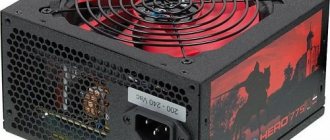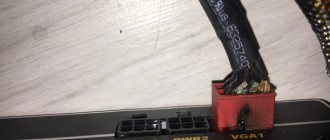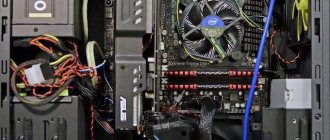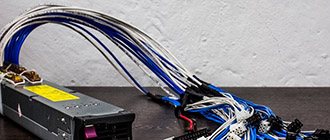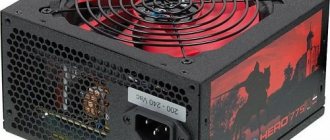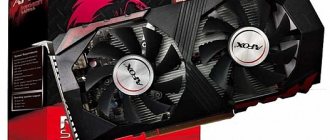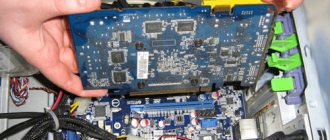When choosing a power supply, the first thing you need to pay attention to is the interface standard (ATX 2.0, ATX 2.2, ATX 2.3). The power supply standard must match the motherboard standard. In 2003, the main power connector for the motherboard was expanded by 4 pins: from 20pin to 24pin. This was necessary to support PCIe video cards, which consume up to 75 W from the motherboard.
ATX 20, 20+4, 24
Main 24-pin power connector and 20+4 pin power connector
If the video cards do not have enough power received through the PCI-Express connector, then use an additional 6-pin cable from the power supply. The additional power connector for PCI-Express video cards is similar to the additional power connector for the processor.
ATX P4
4-pin connector for processor power and 6-pin connector for additional power for PCIe video cards
ATX P4 was introduced by Intel for the Pentium 4 processor. It connects to the motherboard and powers the processor.
Today, most motherboards have between 4 and 8 pins. The new power supply standards use an 8-pin connector (sometimes called 12V EPS) made up of 2 x 4-pin blocks, ensuring compatibility with older motherboards and the classic ATX P4.
Molex
Molex connector is designed to provide power to UltraATA hard drives and other devices (CD, DVD drives); even some video cards required this connector. But due to the growing popularity of SATA hard drives, the number of Molex connectors in power supplies has decreased.
Molex power connectors for ATA hard drives and CD and DVD drives.
SATA
A modern computer must have at least 4 connectors for powering drives in the SATA standard.
SATA power connector.
PCI Express
Modern video cards require more power, so they must be powered directly from the power supply. For this, a PCI Express connector is used. If you are planning to purchase a powerful video card, make sure that your power supply has at least two PCI Express slots, including a convertible one:
If your power supply does not have an 8-pin connector, there are all sorts of 6-8 adapters on sale. One of them:
Floppy connector
Floppy drive connector. Has not changed since 1980
No additional power supply
Naturally, not a single graphics accelerator can work without it - after all, it is a complex design consisting of many chips and logical blocks.
p, blockquote 2,0,0,0,0 –>
The main power consumers in a video card are the graphics accelerator, video memory and cooling system (if active), and to a lesser extent all other components.
p, blockquote 3,0,0,0,0 –>
Budget graphics cards do not have outstanding power, although they cope well with office tasks and therefore do not consume a lot of energy. In addition, they usually have a passive cooling system - just a radiator, without a cooler.
p, blockquote 4,0,0,0,0 –>
To power such a device, the voltage supplied via the PCI‑E interface is sufficient, and no additional electricity is needed - 75 Watts from the motherboard is quite enough.
p, blockquote 5,0,1,0,0 –>
When assembling such a computer, you can limit yourself to a low-power unit - no more than 400 W. As a rule, this power is enough to provide energy to all components.
p, blockquote 6,0,0,0,0 –>
In addition, workhorses usually rarely undergo upgrades, so that in 5 or 10 years they will be able to run the programs necessary for work.
This does not apply to PCs used in design studios or design bureaus: running Photoshop or AutoCad requires a more powerful computer, often with a good graphics card.
p, blockquote 7,0,0,0,0 –>
In conclusion
When building or upgrading a PC, always consider the combined power consumption of your components. It should not exceed the power of the power supply. Overloading the power supply can lead to machine malfunctions, freezing, Windows blue screen errors (or analogues in other operating systems), unexpected reboots, and damage to the power supply.
If you are assembling a computer, look several years ahead, take into account possible upgrades and, based on this, choose the appropriate power supply.
It would not be amiss to remind you that any violation of the integrity of the power supply housing (for example, replacing its fan) and re-soldering of wires will void your warranty. When independently identifying faults with the power supply or motherboard, use only high-quality electrical appliances to measure power and voltage.
With additional
They sometimes, and on gaming computers, almost always use powerful video cards, which often require additional power, since the voltage supplied through the connection interface is not enough.
p, blockquote 8,0,0,0,0 –>
This need can be determined by the appearance of the video card: on the reverse side (most often) of the PCI‑E connector they have a slot for additional power supply. If the card is quite powerful, but does not have a connector for additional power, then it is simply not required.
p, blockquote 9,0,0,0,0 –>
Today you can see the following slots:
p, blockquote 10,0,0,0,0 –>
- 6 pin – older version and less powerful;
- 8 pin - appeared relatively recently, differs in the supply of higher voltage.
The correct pinout assumes that one wire is supplied to each pin: half of them are “pluses”, half are “ground”. A voltage of +12 V is supplied to each plus. Accordingly, you can already calculate that the six-pin connector supplies 36 V (and 75 Watts), and the eight-pin connector supplies 48 V (and 150 Watts). Are there any options? There are, but more about them below.
p, blockquote 11,1,0,0,0 –>
Tire
A very important element is memory bus and its bandwidth. It is she who drives information between the graphics adapter processor and its memory. Memory frequency and bus affect the performance of the video card. The frequency is measured in MHz (megahertz), and the higher it is, the faster the memory works. The bus is measured in bits, from 64 to 448 bits. The “wider” the bus, the faster the memory interacts with the graphics processor (GPU).
The most common bus size is 128bit. However, the top level is 256 and 384. Thanks to the bus size and clock frequency, in principle, its throughput is built. The higher these indicators, the faster the GPU communicates with video memory.
A little about blocks
Budget Chinese power supplies, created on the knee in Grandfather Liao's basement (such, unfortunately, still come across), have one bad property: the number of “zero” wires in them does not always correspond to the standard pinout.
p, blockquote 12,0,0,0,0 –>
Accordingly, the power of such a unit may turn out to be less than declared, and in terms of reliability they do not shine - if you manage to operate such a device for at least a year, consider yourself very lucky.
p, blockquote 13,0,0,0,0 –>
And now I’m gradually bringing you, friends, to the worst thing: top-end video cards don’t have enough power, even an 8-pin connector. For example, the GTX 1080 Ti consumes 250 Watts and requires one six-pin and one eight-pin connector to connect it. That's why such devices have two connectors.
When selecting components, you should pay attention to what connectors are on the video card and whether the power connectors on the wires coming from the power supply correspond to them.
p, blockquote 14,0,0,0,0 –>
You should also know that there is a so-called “universal” 6+2 pin connector. It has 6 pins, grouped monolithically, as a single block, and two more can be connected using a special latch.
p, blockquote 15,0,0,0,0 –>
What to do if you bought components, but it turned out that the power supply does not have the required plug? You can always purchase a special adapter with a SATA or Molex connector - at least one cable, in most cases, will remain free.
p, blockquote 16,0,0,0,0 –>
Which one you connect through the adapter does not matter: the same power is supplied to them.
p, blockquote 17,0,0,1,0 –>
I would like to draw your attention to the fact that when assembling a computer, the main thing is not the presence of connectors on the power supply, but its power: it should be enough to provide energy to all components of the computer.
And if you are assembling a computer “for the future,” it is better to take a power supply with a power reserve - it remains to be seen what upgrade it will undergo in a couple of years and what video card you will use at that time.
Main components of a video card
Here are the main components that are present in all video cards.
GPU
The GPU is the main component and heart of the video card. It is also known as GPU and does all the processing for your graphics card. Typically, most graphics cards come with a single GPU, but there are also a few graphics cards that come with dual GPUs. The performance of a GPU is determined by its architecture, known as its architecture. Different GPU series have different GPU architecture. In addition, different GPU manufacturers have their own processor architecture and layout.
For example, currently the latest GPU architecture from Nvidia is Pascal, and from AMD is Polaris. GPUs have hundreds and thousands of cores for parallel processing and multitasking. The functionality of these processor cores is determined by the GPU architecture. Nvidia calls them CUDA cores and AMD calls them stream processors, but they are technically different due to different GPU architectures. Generally, the newer the GPU architecture, the better the performance of the graphics card, and it also has lower power consumption compared to older architectures.
VRAM
This is the second most important component of the video card. VRAM, or video memory, is where all graphics data and game textures are stored for processing by the GPU. Faster memory can actually improve a graphics card's performance to a certain level. It should be noted that memory alone cannot improve gaming performance because if your GPU is weak, you will never have better performance, no matter how fast the RAM is.
There are different types of video memory available for a video card, depending on their speed and bandwidth. The video card memory includes DDR3, GDDR5, GDDR5X, HBM and HBM2 RAM. DDR3 is the oldest and slowest of all and is used primarily in entry-level graphics cards.
GDDR5 is the most popular and frequently used video memory, which is used in budget, mid-range and high-end video cards. GDDR5X is almost twice as fast as GDDR5 and is used in several top-end graphics cards from Nvidia. Nvidia Titan X, GeForce GTX 1080 and GeForce GTX 1080 Ti use GDDR5X memory. HBM (High Bandwidth Memory) and HBM2 are the most advanced graphics card memory modules for gaming and virtual reality (VR) and are used only in high-end graphics cards. Radeon R9 Fury X and Radeon Pro use HBM memory.
HBM memory is faster, takes up less PCB space, and has lower power consumption compared to GDDR5 memory. You can read a full comparison of all these graphics card VRAMs by following the link below.
VRM
The VRM or Voltage Regulator Module is the main circuitry that powers the GPU. The VRM converts higher power supply voltages to lower voltage levels for use by the GPU. Typically, it converts 12V to about 1V to 1.5V (approximately), which is typically the voltage level at which the GPU operates. Along with the GPU and VRAM, VRM is also one of the most important components of a graphics card. A VRM is also called a processor power module (PPM) or simply a voltage regulator.
The number of voltage regulators on a video card varies from card to card. Some video cards have more VRMs than others. VRMs can get very hot, sometimes even hotter than the GPU, and they need good cooling to keep the graphics card from shutting down.
As described above, VRAM and VRM are completely different components and should not be confused with each other.
Cooler
Each graphics card comes with a cooler to keep the GPU, VRAM, and VRM temperatures at a safer level. Video card coolers can be active or passive. With active cooling, the cooler has a heatsink and a fan (HSF), while with passive cooling, the cooler has a single heatsink.
Most graphics cards use active cooling because it typically requires less space and provides better cooling, especially when overclocked, while passive cooling is typically found in entry-level and less powerful GPUs and operates completely silently. But there are some good mid-range graphics cards that also come with a passive cooler or just a heatsink. Additionally, it is not recommended to overclock your graphics card using a passive cooling solution as it has limited cooling capacity.
On the left with active and on the right with passive cooling
The number of fans used in the active cooling system depends on the manufacturer of the video card. Some high-end graphics cards also come with liquid/water cooling or hybrid cooling. You can learn more about graphics card cooling solutions by visiting the link below.
Printed circuit board
The PCB is the base or board on which all the components are mounted, including the GPU, VRAM, VRM, capacitors, sensors, etc., as well as the display ports. High-end graphics cards have more components, so they require a larger PCB compared to mi-range and entry-level graphics cards.
Maximum permissible power
First, let's remember the physics lessons from the school curriculum. There was this formula:
Power is designated by the letter P and is measured in Watts (W). Current strength is designated by the letter I and is measured in Amperes (A). Voltage is designated by the letter U and measured in Volts (V). I will use this formula for all calculations in this material.
When in the article I talk about the maximum permissible power, this should be understood as a limitation imposed by the developers of the power connector. On thematic forums you can often find messages from the series “I connected a bunch of video cards via one PCI-E and everything is fine with me.” With high-quality materials, indeed, this configuration can work for some time, if the author of the message is a thrill-seeker. With low-quality materials, problems may occur even before the maximum current allowed by the standards flows through the adapter.
It is also worth immediately defining the terms. The power connection is the connection of a paired device, that is, consisting of two parts. These parts may have different names in documentation and in colloquial speech. The socket part, as a rule, is located on the device (unless we are talking about adapters, extension cords, etc.). It can be called: socket, female, “mother”, connector, socket. The male part is usually located at the end of the cable and is called: plug, male, male, plug, connector. All these names are widespread and have the right to life. In this article I will use the names “connector” and “socket”.
Some may consider this incorrect, but I will use terms that are familiar to me, so as not to make mistakes myself and not confuse you.
Now let's talk about the connectors that can be found on a modern power supply.
Video memory
The work of the video card is focused on constantly displaying digital images on the screen. There is a need to save information displayed as well as information remaining outside the screen. This task is assigned to the video memory of the card.
Video card memory is similar in properties to computer RAM.
Often card memory is used for marketing, especially in weak (non-gaming and non-professional) video cards. For some reason, the flashy 4 GB of memory immediately inspires confidence in an unprepared buyer. But the same amount of memory is radically different on different video adapters, if we talk about real performance in demanding tasks and modern games. For example, even the most budget gaming video card nVidia GTX 1050 with two gigabytes of memory will perform better in all tasks than any representative of the GT series cards.
The amount of video memory is an important, but not a key indicator.
Video memory is mainly made according to the GDDR standard. Nowadays, users can often find GDDR5 memory. GDDR3 was previously distributed.
Obviously, the higher the number, the better, as each new version had a number of changes that increased bandwidth and clock speed. Currently, active developers include AMD, Hynix and Qimonda.
Motherboard power connector (ATX connector)
There are 20-pin and 24-pin motherboard power connectors. Farms use 24-pin ones, but for compatibility with older motherboards, the four outer contacts are often made detachable. The type of power connector on the motherboard must match the type of power supply connector.
In relation to mining about this connector, it can be noted that four additional contacts are used to power PCI-Express devices; they provide power up to 75 Watts.
Connecting the front connectors
Standard system units usually have power and reset for the personal computer, as well as indicators (light bulbs). They connected to the motherboard through 1-2 pin connectors, which must be connected correctly. These cables contain hints in the form of inscriptions that allow you to understand what each connector is responsible for. To connect them, you need to find a special panel on the motherboard ( F - panel ) and connect the cables, positioning them correctly.
When installing these cables, you must adhere to strict order . Each pin should be connected so that the inscription faces up . The location of their connection is often indicated in the tips near the F-panel on the motherboard itself. However, for convenience, it is recommended to use the following diagram .
Connector layout
It is also worth paying attention to the fact that the Power LED are divided into two 1-pin cables and are divided into “+” and “-”. It is necessary to arrange these pins as indicated in the diagram .
With the standard F-panel arrangement, the result should look like this:
Final result
However, the process is not over.
Often, on the front panel of the system unit there are also USB connectors and 3.5 mm ports for connecting audio devices and a microphone.
USB and 3.5 mm connectors
These cables also contain hints, and it is quite difficult to make a mistake, because... On the motherboard there are also signatures near the sockets required for connection.
CPU Power Connector
There are 4-pin and 8-pin connectors. From the diagram below it is easy to see that the 8-pin is two 4-pin located next to each other. Often the 8-pin one is made composite, similar to the motherboard power connector.
On power supplies, the processor power connector is located on a separate line. Sometimes there is both an 8-pin (non-separable) and a 4-pin on this line at the same time. One of them is connected to the motherboard.
Connecting the drive
Before installing this device, you must determine the connection type.
- IDE
- SATA
Comparison of IDE and SATA types
The drive must be placed in a specially designated place inside the system unit. The standard is the upper front part of the body.
Connecting a drive with an IDE interface type
After installing the drive inside the case, you need to connect the power cable and data cable to it.
The power cable is connected in the same way as the power connectors for the CPU and video card.
cable must be carefully, without force, inserted into the connector on the rear panel of the drive.
Connecting the data cable to the drive
The other end of the cable must be connected to one of the IDE controller channels on the board.
Location of IDE controllers
- Number 1 in the figure shows IDE controller on which two devices with jumpers Master and Slave .
- Under the number 2, the IDE controller can also include two devices . In master mode, this is the Master jumper, and in slave mode, this is Slave.
- Number 3 is the floppy drive .
To select the required jumper (Master or Slave), you need to inspect the drive housing. The jumper position is indicated there.
All that remains is to fix the drive to the system unit with 4 bolts, which are included in the package.
Connecting a drive with a SATA interface type
Installing a SATA drive (used in modern devices) is identical to installing an IDE drive. The difference lies in the connector that needs to be connected to the drive and the motherboard.
It is worth noting that the power connector on modern drives is different from the power cable mentioned earlier. Below is a photo of connecting the SATA cable and the new power cable to the drive.
Left – power cable, right – SATA
It also happens that the drive has an old power connector, but uses the SATA interface type. Such drives are used very rarely, but they exist.
All that remains is to secure the drive in the case with 4 bolts and check whether it is securely fixed.
PCI-E connector
It is this connector that is designed to power video cards; power supply manufacturers often make them red (and some blue) in color; there are 6-pin and 8-pin. In modern power supplies, the 8-pin can be composite, just like the connectors described earlier.
The PCI-E connector is the most popular in mining. Its purpose is to provide additional power to devices (video cards, in our case) connected to the PCI-Express bus of the motherboard. According to the specifications, the 6-pin provides 75 watts of additional power, and the 8-pin provides 150 watts. At the same time, the video card receives another 75 watts from the motherboard (or from the riser).
Course on video cards for mining:
The video card may have several connectors for additional power. For example, you can take the NVIDIA GeForce GTX 980 Ti video card; its maximum power consumption, according to the manufacturers, is 250 Watts. Of this, the device receives 75 Watts from the motherboard, and connectors for at least 175 Watts are required. One 6-pin is not enough (up to 75 Watt), one 8-pin or two 6-pin (up to 150 Watt) is also not enough. Requires one 6-pin and one 8-pin (total 225 watts). Look at the picture below - that’s right, everything is correct.
Peculiarities
It's no secret that modern power supplies (PSUs) have become more powerful, have improved characteristics and, of course, a modern design than their predecessors 10-15 years ago. Also, many of you know (or are learning now) that modern power supplies have new connectors for components not previously used in personal computers (PCs). The presence of new connectors is associated with the emergence of new (or modernization of old) computer components, improvements in their performance characteristics and, as a result, the need for additional power.
On the market, in addition to conventional ones, you can find modular or partially modular power supplies. A distinctive feature of a modular one from a regular one is that the cables from the block are replaced with connectors for connecting cables with connectors. So, you can disconnect unused cables in the power supply, freeing up space in the system unit for better ventilation.
A modern power supply meets energy efficiency and efficiency certification standards that are used to distribute power and efficiently deliver power to computer components. Due to the “greater gluttony” in power supply of the same video cards and motherboards, the power supply contains additional wires, contacts and connectors.
Molex connector
Initially, this connector was designed to power hard drives and floppy drives, but currently for modern devices this function is performed by SATA connectors (about them below), and Molex connectors are used to power various additional equipment.
The advantage of Molex is the presence of 5 and 12 Volt lines at the same time, and a current of up to 11 Amps can flow through each line, that is, the power of a 12-Volt line is 132 Watts, and a 5-Volt line is 55 Watts. You can often find information on the Internet that Molex provides 187 watts of power. This is true, but the additional power connector for video cards has only 12 Volt lines, and the 5 Volt line is not used. In mining rigs, Molex connectors are used to connect risers, cooling fans, additional power to the motherboard, and as a replacement for missing PCI-E connectors.
Connecting a sound card
Installing an internal sound card is very similar to connecting a video card . The only difference is in the ports to which this device should be connected .
- PCI port
- PCI-Express x1 port
Comparison of PCI and PCI-Express x1 ports
Connecting a sound card to the wrong port will be difficult and most likely even impossible . The length of PCI and PCI-Express x1 slots is radically different .
You also need to remove the plug from the back wall of the system unit, and then carefully insert the sound card into the desired port. Most motherboards do not have a lock on these connectors, so there will be no click when connected tightly.
After these steps, you need to secure the sound card with the fastening bolt left after the plug was removed. It is recommended to make sure that the sound card is connected securely and does not wobble in the socket.
No additional power is required (except for professional models).
SATA connector
Like MOLEX, this connector is designed for connecting hard drives and floppy drives.
From the diagram it can be seen that the connector has three contacts for 3.3 V, 5 V, 12 V. According to the specification, each connector is designed for a maximum current of 1.5 A. Thus, the total power of the 3.3 V lines is almost 15 Watts, 5 V lines are 22.5 Watts, and 12 V lines are 54 Watts. Thus, the maximum power of the 12 V line for this connector is three times less than that of Molex. And the 5 V lines are two times smaller.
That is, you CANNOT use SATA->Molex connectors to power devices that consume more than 50 Watts.
Graphics Processing Unit (GPU)
GPU (graphics processing unit) is the “heart” of the video card, which is responsible for mathematical calculations of the image displayed on the screen. In other words – graphics processing. The GPU is similar in properties to the central processing unit (CPU) of a computer, but is designed to create images.
Frequency
One of the most important characteristics of a GPU is the clock speed. Everything is simple with her. It is measured in megahertz and the higher its value, the faster the information is processed. The frequency of modern video cards reaches 1000-1400 MHz.
Technical process
An important indicator is the technical process; this is one of the first points among the characteristics of video adapters. Measured in nanometers.
Roughly speaking, the main driving force is transistors. If you take modern video cards, you will notice that the nanometer indicator is getting smaller and smaller with each generation of video chips. All this is due to the fact that the smaller the transistors are, the more they can be placed on one video chip.
As the size of transistors decreases, in general, video cards also decrease:
- Energy consumption;
- Thermal Dissipation (TDP);
At the same time, productivity increases, since more computing power can be accommodated in one area.
The smaller the process, the better.
How to replace a video card on a computer
First of all, in order to change the video card, you need to remove the old driver. To do this, you need to turn on the computer. A driver is a kind of software through which the operating system coordinates the operation of other components.
- Windows OS: uninstall via Device Manager. Open the Start menu, then enter “Device Manager” in the search. Then find the "Video Adapters" tab. Click and remove your video card; to do this, strictly follow the instructions on the monitor. After removal, according to many users, the image quality decreases and becomes blurry.
- Mac OS X: driver removal is not required when upgrading a video card.
Finish the job. Turn it off, and then disconnect all cables and wires, including those from the video card (if there is one).
Remove the left side wall of the system unit.
Next, find the slot to which the video card connects. Most often this is the PCle port, which is located almost next to the processor. To determine the exact name and type of slot, check the documentation for your motherboard. It may also contain a built-in video card or be completely empty.
To further work with the system unit, you need to be grounded. Static electricity can cause damage to other system components when upgrading a video card. To do this, use a special bracelet or touch the metal tap with your hand.
Use a screwdriver to unscrew the screws connecting the video card to the case. Remove it carefully.
How to connect a gtx 560 video card
Some video card models require additional power to work correctly. This is due to the fact that it is impossible to transmit so much energy through the motherboard, so the connection occurs directly through the power supply. In this article we will describe in detail how and with what cables to connect the graphics accelerator to the power supply.


